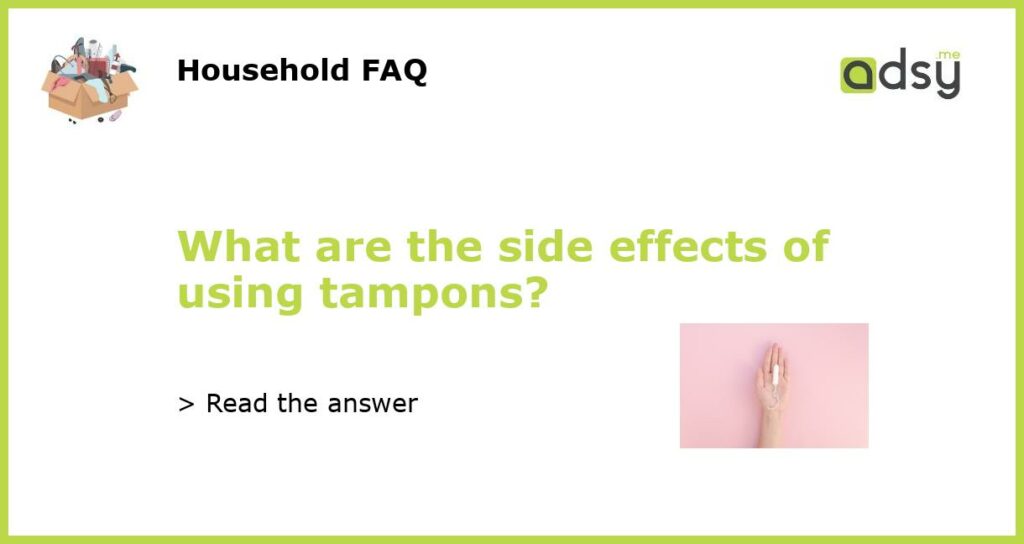Introduction
Tampons are a common menstrual product used by women worldwide. They provide convenience and discretion during periods, allowing women to carry on with their daily activities without interruption. However, like any product, tampons come with potential side effects that users should be aware of. In this article, we will explore the various side effects of using tampons and discuss ways to mitigate them.
Possible Side Effects of Using Tampons
2.1 Toxic Shock Syndrome (TSS): One of the most well-known and serious side effects of using tampons is TSS. TSS is a rare but life-threatening condition caused by certain strains of bacteria, particularly Staphylococcus aureus, which can multiply rapidly in the vaginal environment. The use of tampons, especially those with higher absorbency levels and extended wear times, increases the risk of developing TSS. Symptoms of TSS include high fever, rash, low blood pressure, and organ failure. To minimize the risk of TSS, it is essential to change tampons regularly, use the lowest absorbency necessary, and consider using alternative menstrual products like pads or menstrual cups.
2.2 Vaginal Dryness and Irritation: Another common side effect of using tampons is vaginal dryness and irritation. Tampons can absorb the natural moisture in the vaginal area, leading to dryness and discomfort. This can result in itching, burning, and general discomfort during both menstrual and non-menstrual periods. To prevent or alleviate vaginal dryness, it is crucial to opt for tampons with lower absorbency levels, change them regularly, and consider using lubricated tampons if necessary. Using water-based lubricants can also provide relief and reduce friction.
2.3 Allergic Reactions: Some women may experience allergic reactions to the materials used in tampons, such as synthetic fibers or fragrance additives. Symptoms of an allergic reaction may include itching, burning, redness, swelling, and rash in the vaginal area. If you suspect an allergic reaction to tampons, it is advisable to switch to hypoallergenic tampons or alternative menstrual products made from natural materials like cotton. Consulting with a healthcare professional can help determine the underlying cause and provide suitable alternatives.
2.4 Disruption of Vaginal pH Balance: The vaginal environment has a delicate pH balance that helps maintain a healthy and protective microbial population. However, using tampons can disturb this balance, leading to an overgrowth of harmful bacteria or yeast. This can result in conditions like bacterial vaginosis or yeast infections, which cause symptoms such as abnormal discharge, itching, and discomfort. To minimize the risk of disrupting the vaginal pH balance, it is important to change tampons regularly, avoid using scented tampons or those with added chemicals, and maintain proper hygiene practices.
2.5 Leakage and Staining: While tampons are designed to absorb menstrual flow, there is still a possibility of leakage, especially if they are not changed frequently or are not the right absorbency level for the flow. This can not only lead to staining of clothing but also cause embarrassment and discomfort. To prevent leakage and staining, it is crucial to choose the appropriate absorbency level for your flow, change tampons regularly (usually every 4-8 hours), and consider using additional products like panty liners for added protection.
Conclusion
In conclusion, while tampons are a popular choice for menstrual management, it is important to be aware of their potential side effects. Toxic Shock Syndrome, vaginal dryness and irritation, allergic reactions, disruption of vaginal pH balance, and leakage/staining are some of the possible side effects associated with tampon use. By understanding these side effects and taking appropriate precautions, women can make informed decisions about their menstrual hygiene and choose alternative products or strategies if necessary. Regular communication with healthcare professionals can provide valuable guidance and support in managing any side effects effectively.






